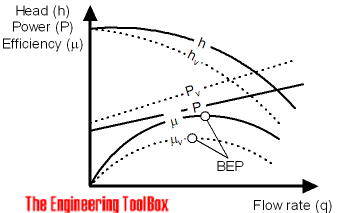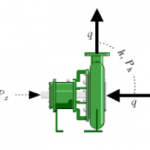Hydrodynamic losses through pumps depend on fluid viscosities.
When a more viscous fluid is handled by a centrifugal pump
- the power requirement of the brake increases
- the generated head is reduced
- capacity is reduced
- pump efficiency is reduced and the Best Efficiency Point – BEP – is moved

The head, flow rate and capacity with fluids with viscosities different from those used in the original documentation can be modified with coefficients.
Flow
q v = c q q (1)
Where
q v = flow compensated for viscosity (m 3 /h, gpm)
c q = viscosity flow coefficient
q = original flow according to pump curve (m 3 /h, gpm)
Head
h v = c h h (2)
Where
h v = height compensated for viscosity (m, ft)
c h = viscosity load coefficient
h = original head according to pump curve (m, ft)
Efficiency
m v = c m m (3)
Where
m v = efficiency compensated by viscosity
c m = viscosity efficiency coefficient
μ = original efficiency according to the pump curve
Power – SI units
P v = q v h v r v g / (3,6 10 6 m v ) (4)
Where
P v = power compensated by viscosity (kW)
r v = density of the viscous fluid (kg/m 3 )
g = acceleration due to gravity (9.81 m/s 2 )
Power – imperial units
P v = q v h v SG / (3960 μ v ) (5)
Where
P v = viscosity compensated power (bhp)
SG = specific gravity of viscous fluid
Source: https://www.engineeringtoolbox.com/centrifugal-pumps-viscosity-d_670.html










